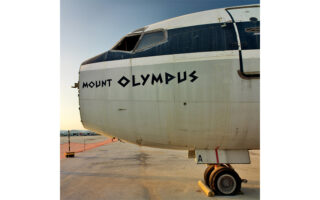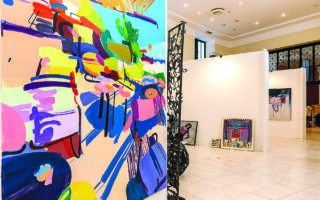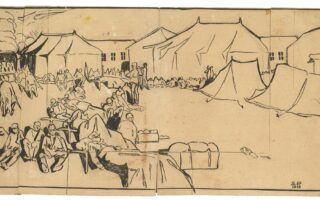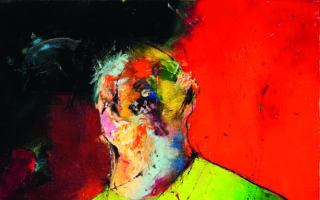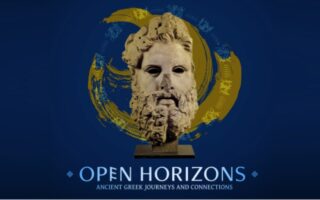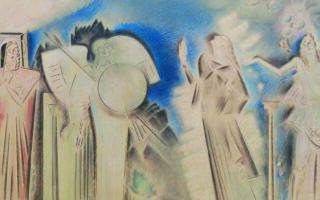Love springs from a house of butterflies
Piraeus-born photographer on, finally, sharing his prodigious China archive

“It’s time for it to come out,” Pavlos Kozalidis says on a Skype video call from his home in the seaside village of Oropos, northeast of Athens. An astoundingly prolific photographer and a pointedly media-shy figure, Kozalidis, now 60, has spent nearly 40 years traveling around the world with his camera. Over that time, he has very rarely paused to show his images to the public – most notably, in a 2008 solo exhibition at the Benaki Museum in Athens with photographs from the lives of ethnic Greeks in the Black Sea region which confirmed him as an authentic lensman gifted with candid, raw sensitivity. More recently, a period of painful personal loss saw him sink into his China archive. “I got down to business, scanning some 10,000 images,” he says. “It was a lifesaver.”
About 70 of them, all shot on black-and-white film, will go on display next week, once again at the Benaki. Making such a narrow selection was certainly not an easy task. Built over roughly a quarter of a century, the collection has grown to a gasping 120,000 images. Kozalidis first visited the Asian country in 1989, around the time of the Tiananmen Square protests. The Communist government’s bloody crackdown on student-led pro-democracy protests was not what drove him there. “I was looking for the Cultural Revolution,” he says of the decade-long upheaval unleashed by China’s “Great Helmsman,” Chairman Mao Zedong. “Basically, I saw the very, very tail end of that,” he adds, recalling his fascination with the archetypal images he had first encountered in Vancouver Magazine of rice-hatted Chinese farmers plowing their fields with cows. “Always with a smile on their face. It was all very, very patriotic.”
As many as 2 million people died in Mao’s campaign to reinvigorate the Communist revolution by strengthening ideology and purging rivals between 1966-76. “It was one of the most turbulent times in China. It was horrific. People really, really suffered,” Kozalidis says. However, he takes care to emphasize, it was not politics that drove him there, but an insatiable curiosity about the world. “When I started to photograph, I didn’t want to change the world. I wanted to see the world. I wanted to experience the world,” he says. “I was just madly interested in this country. I fell in love with China and its people.” He never depicted the poverty. “I don’t like photographing poverty. It’s like somebody coming to your house with a camera and trying to root out the ugliest things. And where he encountered poverty, he would try to capture it in a way that cherished the dignity of the people. “I was basically invisible. My photography was about people; people without bothering them,” he says. His Greek passport made navigating and interacting with locals a little less difficult, he says. “The Chinese love the Greeks; they really respect this country. We are deeply embedded in their history. We are in their psyche.”

And, indeed, he traveled all around China. Sometimes he would come in through Pakistan, others he would follow the route through India, Nepal and Tibet. He has also crossed into China though Vietnam, Hong Kong and Japan, and once traveled on the Trans-Siberian railway from Moscow to Beijing. He never really planned a route. “I just arrived at places. I did not really follow some great plan. I just wandered around China. I would just get on a train or a bus. I often arrived at some place just because I liked the station and I would get out. And it turned out to be a wellspring of photographs.” Kozalidis was a stranger to comfort, taking long-distance, occasionally perilous journeys on third-class buses and trains, and sleeping at very basic dormitories for foreigners. “You have to have almost a mad curiosity to put yourself through traveling this way,” he says. “Now I am paying for it. My body is wrecked.”
Butterfly effect
Kozalidis was born in the Attica port city of Piraeus. Growing up as a boy in the working-class suburb of Drapetsona, he was familiar with the sight of Egyptian seamen, but had never encountered a Chinese person. His fascination with China would be sparked a few years later in another port city across the Atlantic, in Vancouver, Canada, where his family moved when he was 5. “I was just totally awestruck by them.”
 He liked to hang around Vancouver’s Chinatown, started by immigrant laborers in the 1880s, but the pivotal moment came when he visited the house of a Chinese classmate and fellow bully target Peter Wong. The Wongs’ apartment featured all the typical Chinese decoration, and a portrait of Mao hung on the wall just above the refrigerator. “Outside it was a totally different world that I was still learning. And then there was this world of China and this house that overwhelmed me. I just fell in love with these people,” Kozalidis says. He was mostly captivated by the decorative antique boxes with butterflies from around the world – animal symbols of happiness and longevity. “It was the whole house. There were just zillions of butterflies. They were everywhere. It was that house that gave genesis to my curiosity,” he says. Nevertheless, the butterfly effect would kick in around 20 years later, when Kozalidis took his first actual trip to the vast Asian country.
He liked to hang around Vancouver’s Chinatown, started by immigrant laborers in the 1880s, but the pivotal moment came when he visited the house of a Chinese classmate and fellow bully target Peter Wong. The Wongs’ apartment featured all the typical Chinese decoration, and a portrait of Mao hung on the wall just above the refrigerator. “Outside it was a totally different world that I was still learning. And then there was this world of China and this house that overwhelmed me. I just fell in love with these people,” Kozalidis says. He was mostly captivated by the decorative antique boxes with butterflies from around the world – animal symbols of happiness and longevity. “It was the whole house. There were just zillions of butterflies. They were everywhere. It was that house that gave genesis to my curiosity,” he says. Nevertheless, the butterfly effect would kick in around 20 years later, when Kozalidis took his first actual trip to the vast Asian country.
Deeply humanistic
Kozalidis, who has shot in black-and-white as well as color (Kodachrome) in 35mm, 6×6 and panoramic format, would always come back with some stunning shots, drawing on his favorite themes: community life, social traditions, religious rituals. A particularly atmospheric image included in the Benaki exhibition depicts a headless statue of Mao at 798 Art Zone in Beijing’s Dashanzi district. In another, worn-out workers sleep on a train to Urumqi, the capital of China’s far western region of Xinjiang. A stunning shot in a field near the Afghan border shows horsemen playing buzkashi, a rugged equestrian game played for centuries across Central Asia. There are snippets of humor also, like a picture of an elderly storeowner putting on a playful show to demonstrate the use of a dragon mask to the curious photographer.

Aesthetically powerful and deeply humanistic, his images extend on the classical photographic tradition – or “visual language,” as Kozalidis prefers to call it – of Marc Riboud or Henri Cartier-Bresson. Kozalidis nevertheless prefers to keep modest about his artistic aptitude. “I don’t know if I did anything new in photography. I’m sure I didn’t. I would have liked to,” he muses. “The work is so personal that it becomes universal. Because it is not trying to be anything,” he asserts a bit later, in a statement that emits confidence in the value of his work. The body of work no doubt is precious, if only as a historical record. “Visually, I have 35 years of the past world; some 800,000 photographs,” he explains. Kozalidis estimates that by the end of his career, a word that would most likely raise his eyebrow, he will have shot nearly 1 million images. “There is value in that, and I know this,” he says.
As the sheer volume of his output suggests, photography is an obsession for Kozalidis. Besides China, he has photographed in nearly 80 countries, including in South and Central America, Africa, India and Greece. In one of his most ambitious and still not quite complete projects, he has followed the trail of Alexander the Great through the Eastern Mediterranean, Egypt, the Middle East and parts of Asia, “looking for ghosts.” Very little of that work has seen the public light. “I really didn’t care to show. It may sound very arrogant, but it was all for me. I was not doing it for anybody else. I was trying to keep my sanity. Photography gives me purpose, it gives me passion, it gives me all the best things I need to carry on.”

How much longer will his roll of film last? “I have a passion for it and a love for it. I know that if I don’t do it, I get a bit squirrely. And I still have the curiosity. I just hope my body also carries on,” he says.
Unsurprisingly, Kozalidis takes absolutely no interest in social media. “Photography has become so saturated with zillions of photographs and they’re all being shared – and I’ve kept this dinosaur kind of ideology. I made these photographs for myself,” he says. Nor does he see the excess and the narcissism of our image-propelled era as a threat to the craft. “Photography is not art, it is magic,” he says. “It is there to stop time. It is to freeze the beauty of a person to see it in the future. How can that ever go out of style?”
Pavlos Kozalidis’ photo exhibition “House of Butterflies” will go on display at the Benaki Museum’s (benaki.org) Pireos Annex from October 6 to November 20. The exhibition has been curated by Thomas Asimakopoulos and Senka Trivunac.
